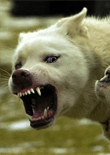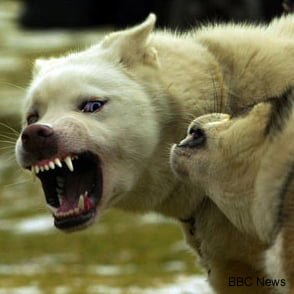How to Deal with an Aggressive Dog
By Sally Gutteridge | Behavior

 When you talk to another person in day-to-day life, you pick up on hundreds of body language cues without even realizing it. But did you know that your dog gives off the same cues regarding their temperament, mood, and behavior by using their body language?
When you talk to another person in day-to-day life, you pick up on hundreds of body language cues without even realizing it. But did you know that your dog gives off the same cues regarding their temperament, mood, and behavior by using their body language?
When it comes to managing an aggressive dog, understanding body language is key. Assessing the body language of an aggressive dog can mean the difference between getting bitten and stopping a violent situation before it starts.
Here are several basic body language cues in an aggressive dog:
Some of the behavioral cues listed above are obvious, like snarling or growling. Other behavioral cues from an aggressive dog are more subtle, like narrow eyes and a rigid body position.
Defensive Aggression versus Aggressive Attack
There’s a dramatic difference between defensive aggression and an aggressive attack. If a dog feels like they’re in danger, they will exhibit a fight-or-flight response, similar to humans. An example would be if a dog is on a leash and becomes frightened by another dog. His natural instinct will be to flee, but he may be forced to go on defensive attack if he is held captive on a leash.
Many people believe that a dog this situation is an aggressive dog, but this dog is actually fearful. This behavior is what is known as defensive aggression.
Here are several behavioral cues to make a distinction:
Clearly, the body language between a defensive and an aggressive dog is quite different. A defensive dog is reacting out of his flight instinct; an aggressive dog is reacting out of his fight instinct.
How to Prevent a Dog Bite
Whether a dog is defensive or aggressive, he may be prone to bite if he feels threatened or attacked. Understanding both of the behavioral cues listed above will make it easier to manage a situation if a dog is snarling and showing signs that it may bite.
According to the Humane Society, the worst thing that you can do when faced with a defensive or aggressive dog is to turn your back and ran away.1
This again plays into the natural instinct of a dog to chase you, catch you, and bite you. Another fairly obvious tip to prevent a dog bite is to never disturb a dog when it is eating, sleeping, chewing on a toy, or caring for puppies.
If a dog has shown aggressive behavioral cues, you can use the following tips to prevent an attack:
If your dog is showing signs of aggression, the best thing that you can do to prevent him from biting or attacking is to socialize him. Find a trainer that works well with aggressive dogs in order to slowly condition your dog to accept new dogs and strangers.
Additionally, if your dog has not been spayed or neutered, this could greatly reduce aggression and make it easier to socialize your dog in new situations. A routine procedure like neutering will make your dog less likely to fight with other dogs and bite strangers.
Make no mistake – aggression is a serious issue that needs to be addressed immediately. Avoiding or ignoring the behavioral signs listed above will only make the problem worse and could endanger those around you.
Sources:
Session expired
Please log in again. The login page will open in a new tab. After logging in you can close it and return to this page.
Jean, i love all the things you post, usually, but i disagree with many of the remarks in this post.
like this remark:
//”Additionally, if your dog has not been spayed or neutered, this could greatly reduce aggression and make it easier to socialize your dog in new situations. A routine procedure like neutering will make your dog less likely to fight with other dogs and bite strangers.”//
Provably false. The only fights a neutered dog will be less likely to engage in, are those over mating rights.
An aggressive dog does not improve when neutered. This is a myth.
If you have an aggressive dog,
and you have him or her spayed or neutered,
you will now have an aggressive dog
who can not reproduce.
Thanks tigerlily. 😉 I don’t have lots of experience dealing with aggressive dogs personally and this post was written more from what I’ve heard than from experience. Thank you for clarifying this for the readers. Much appreciated. 😉
well, on second thought, your post is directed more towards helping humans avoid dog bites, so my commentS are mostly a derail for the points you are making——-SORRY!!!
Aggressive dogs are born this way. Dog-aggression typically manifests at about 9 mos old. (Shy dogs, who show up in the litter box as shy, these dogs, if they do develop aggression, tend to have primary target of humans for their aggression, which manifests at about 6 mos old)
ANY dog can be temporarily aggressive, any dog at all, if the perfect storm of factors occurs.
But to be PERSISTENTLY aggressive for life,
towards most unknown humans (the shy dog)
or
towards most unknown dogs (the dog-aggressive dog)
THAT is genetic.
There are decades and decades of research which prove,
dogs who have inappropriate aggression
have
multiple abnormal neurobiological differences that have never ever been found in ‘normal’ dogs..
Aggressive dogs always have:
smaller, misshapen amygdalas in their brains (you have an amygdala, too, and in humans, it is thought to control emotions, but, it is not clear if this is true of dogs as well). Several abnormal brain features are visible on MRIs and P.E.T. scanners.
and all aggressive dogs have
abnormal numbers of serotonin receptors on the surfaces on their cortex,
abnormal neurochemistry in their bloodstreams,
with disturbances in their levels of
adrenaline,
dopamine,
zinc,
omega 3s
serotonin,
etc
to name a few.
I will post an article about the genetics of dog aggression in the forums soon. No one but no one ever refers to research, and there are tons of scientific research on this, from universities, veterinary research teams, labs, etc, from all over the globe. All veterinary research teams agree, there are multiple genetic neurobiological and neurochemical disorders involved in the PERSISTENTLY aggressive dog.
But the advice to BACK away is spot on awesome advice. Dogs are less likely to bite the front of person.
also, great advice to hold out an object, the dog will bite the closest part, be it a bookbag, a purse, a jacket, whatever.
hi my loving border collie will play all day say with 3 other dogs new to her and sudenly she will go into fight mode with another dog that comes along , she is 22month old has a domenant moment with the mother dogat times
Hello! My 8 month old Indian hound (native dog to India) was always sweet as pie to us. Always cuddling up to us where ever me and my husband were. When he was about 5-6 months we had a dog trainer over and he taught us basic commands, how to walk him properly, making him sit for his food etc. Our dog mastered them and listens well (for the most part but not when he is distracted). Almost right after we started the training our little guy started to get aggressive with his food or of any food item he would grab off a counter if he had the chance. Now he started growling and snapping when he’s laying down and doesn’t want us to pet him. He’s more so like this in the morning when my husband is leaving for work. I could be petting him but when my husband comes over to tell me good bye, tika will growl and sometimes snap at him. He will growl even if we walk by him sometimes just to say “hey I’m comfortable don’t come near me. ” I understand how to avoid not getting bitten, but I really need help with fixing the problem. He is also always guarding his food and has attacked me several times just for exchanging his glance. When you walk by him while he’s eating he will growl. I do get it, look away so he doesn’t feel challenged, but when happens when I have children and the wander over to him when he’s in a mood. I need help fixing this problem, any advice is welcome.
And I just wanted to add, he is super submissive to all dogs. To the extent that he sometime gets teamed up on because he lays down and rolls over so quickly when he’s playing with other dogs. He loves all dogs!